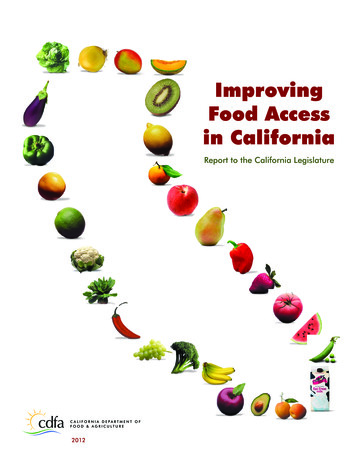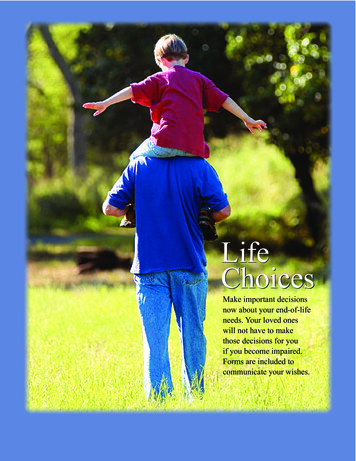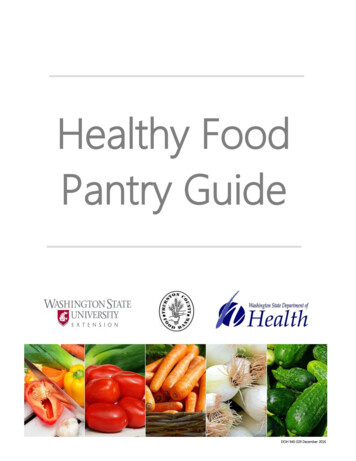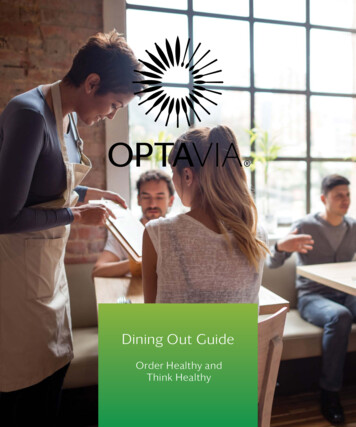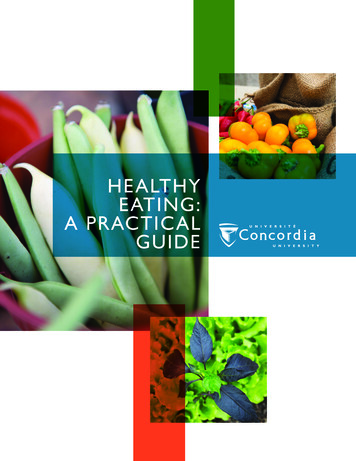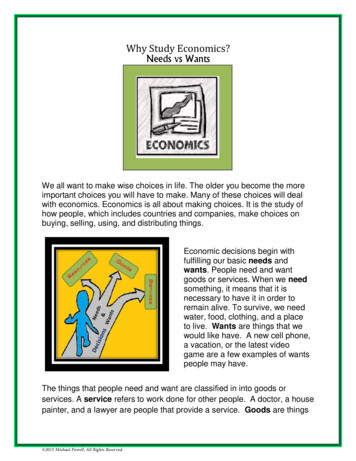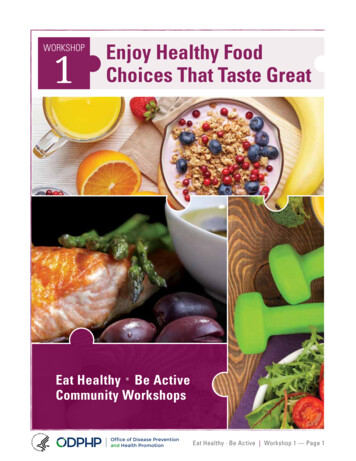
Transcription
WORKSHOP1Enjoy Healthy FoodChoices That Taste Great·Eat Healthy Be ActiveCommunity WorkshopsOffice of Disease Preventionand Health PromotionEat Healthy · Be Active Workshop 1 — Page 1
WORKSHOP1Table ofContentsInstructor Guide . . . . . . . . . . . . . . . . . . . . . . . . . . . . . . . . . . . . . . . 5Workshop Lesson Plan . . . . . . . . . . . . . . . . . . . . . . . . . . . . . . . . . . 7Handouts . . . . . . . . . . . . . . . . . . . . . . . . . . . . . . . . . . . . . . . . . . . . 15Eat Healthy · Be Active Workshop 1 — Page 3
WORKSHOP1InstructorGuideBEFORE WORKSHOP BEGINS Thoroughly read entire workshop and becomefamiliar with the lesson plan.Choose an activity to do, and gather materialsneeded for the icebreaker and the chosen activity. Icebreaker: large and small disposable plates,salt-free pretzels, olive oil, a selection of spices(hint: consider buying spices from a food coop where you can buy small amounts for lessmoney), and a plate/tray for the spices Activity 1: paper plates, crayons/markers/etc.for each person Activity 2: sugar, can of soda, plate, teaspoon Photocopy handouts (1 per participant):1. Enjoy Healthy Food Choices That TasteGreat (2 pages)2. Find Someone Who (1 page)3. Tips for Healthier Choices (2 pages)4. Understanding and Using the Nutrition FactsLabel (1 page)5. Cut Down on Sodium (2 pages)6. Reduce Your Sodium (Salt) Intake (1 page)7. Modifying a Recipe: Lasagna, RecipeMakeover (2 pages)8. MyPlate 10 Tips to ChooseMyPlate (2 pages)9. Workshop Evaluation (1 page)Eat Healthy · Be Active Workshop 1 — Page 5
WORKSHOP OUTLINEThe workshop should last 1 hour, including activities. Icebreaker activity (5 minutes) — do this whilepeople are coming into the workshop. Introduction (5 minutes) Explain the purpose of the workshop. Activity (5–10 minutes). Note: Choose aheadof time and gather supplies. If doing Activity1, review MyPlate 10 Tips to Choose MyPlateduring this time. Review the Learning Objectives. Objective 1: List 5 small changes you can maketo choose foods and beverages with healthier fats,less sodium, and less added sugars (5–10 minutes). Review handout: Modifying a Recipe: Lasagna,Recipe Makeover (at-home activity) Review handout: Enjoy Healthy Food ChoicesThat Taste Great Review handout: MyPlate 10 Tips to ChooseMyPlate (2 minutes) Video: Healthy Can Be Tasty (2–3 minutes) Increasing Physical Activity (1–2 minutes) Stretch Break (5 minutes) Modify a recipe to make it lower insaturated and trans fats, sodium, and/oradded sugars.Objective 2: Identify 3 spices, herbs, or salt-freeseasonings that will give you new ways to eathealthfully (5–10 minutes). Review handout: Tips for Healthier Choices Review handout: Understanding and Using theNutrition Facts Label Review handout: Cut Down on Sodium Review handout: Reduce Your Sodium(Salt) IntakeEat Healthy · Be Active Workshop 1 — Page 6Wrap-Up/Q&A (5 minutes) Reminders of things to try at home: Review handout: Find Someone Who Objective 3: Use recipe modifications and cookingtechniques to reduce calories, saturated and transfats, sodium, and added sugars (5–10 minutes). Increase physical activity and reduceamount of time sitting/screen time. Ask participants to complete the evaluation form(5 minutes).
WORKSHOP1WorkshopLesson PlanICEBREAKER ACTIVITYTaste Testing (5 minutes)Spices/Herbs/Seasonings Taste Test: Select 2–3spices, such as thyme, basil, oregano, rosemary, garlicpowder, onion powder, chili powder, low-sodium tacoseasoning, cumin, curry, coriander, salt-free seasoningmixes, etc. As people come into the workshop, offerthem a salt-free pretzel to dip in a small amount ofolive oil and then in a spice. See how they like thetaste and whether they can name the spice/seasoning.Supplies necessary: Largeand small disposable plates,salt-free pretzels, olive oil,a selection of spices (hint:consider buying spices from afood co-op where you can buysmall amounts for less money),and a plate/tray for the spicesTALKING POINTSPurpose of the Workshop (2–3 minutes) Today’s workshop and handouts will give youtips for making meals that both are healthy andtaste great.healthier choices you can enjoy. Find yourhealthy eating pattern and maintain it for alifetime. This means: This workshop is based on the Dietary Guidelinesfor Americans and the Physical Activity Guidelinesfor Americans. The Dietary Guidelines providesscience-based advice for making food choices thatpromote good health and a healthy weight and helpprevent disease. The Physical Activity Guidelinesprovides recommendations on the amount, types,and level of intensity of physical activity needed toachieve and maintain good health. Make half your plate fruits andvegetables — focus on whole fruits andvary your veggies. The Dietary Guidelines supports these selectedconsumer messages. More informationabout the messages can be found atwww.choosemyplate.gov. Everything you eat and drink over time matters.The right mix can help you be healthier now andin the future. Start with small changes to make Make half your grains whole grains. Move to low-fat or fat-free milk or yogurt. Vary your protein routine. Drink and eat less sodium, saturated andtrans fats, and added sugars. Healthy eating and physical activity are thebuilding blocks of a healthier life. The PhysicalActivity Guidelines recommends that adultsbe physically active for at least 2 hours and 30minutes each week — children need 60 minuteseach day. You can stay physically active by doingactivities such as walking, dancing, bicycling, orgardening and by reducing the amount of timeyou spend sitting.Eat Healthy · Be Active Workshop 1 — Page 7
WORKSHOP LESSON PLANTALKING POINTSLearning Objectives (2–3 minutes) List 5 small changes you can make to choose foodsand beverages with healthier fats, less sodium, andless added sugars. Identify 3 spices, herbs, or salt-free seasonings thatwill give you new ways to eat healthfully. Use recipe modifications and cooking techniques toreduce calories, saturated and trans fats, sodium,and added sugars.TALKING POINTSHandout: Enjoy Healthy Food Choices That Taste Great (5–10 minutes) Select lean cuts of beef or pork or lean groundbeef (92% lean or higher) and skinless turkey orchicken breast. Compare sodium in foods like soup, bread,and frozen meals — and choose foods withlower numbers. Choose frozen vegetables without sauces andcanned vegetables that are lower in sodium. Limit your purchase of processed meats such asbacon, sausage, and hot dogs, which tend to behigher in sodium and saturated fats. In addition to fresh fruits, use canned, frozen,and dried fruits. Look for the canned fruit lowestin added sugars. Choose legumes like black or kidney beans orblack-eyed peas or tofu as a main dish or part of ameal as protein sources. Try seafood instead of meat and poultry. Aim to eatabout 8 ounces of seafood per week. Choose whole-grain cereals that don’t havefrosting or otheradded sugars;add flavor tohot wholegrain cerealswith raisins,vanilla, and/orcinnamon.EAT HEALTHY YOUR WAYEnjoy Healthy Food Choices That Taste GreatRead this handout to learn how you can eat tasty foods whilelowering sodium and sugar and switching to healthier fats.Make half your plate fruits and vegetables(especially nutrient-packed ones that are red,orange, and green, as well as legumes like black orkidney beans or black-eyed peas). Choose water, fat-free or low-fat milk or fortifiedsoymilk, or 100% fruit or vegetable juice asdrinks rather than regular soda, sports drinks,energy drinks, fruit drinks, and other sugarsweetened drinks. Instead of a big dessert like regular ice cream,cake, pie, or cookies, try a piece of fresh fruit ora frozen 100% fruit bar, or split a smaller dessertwith a friend.MEET THE PÉREZ FAMILYRoberto, Gloria, and their daughters, Marta and Ana, are finding that eatinghealthy doesn’t mean losing flavor in their foods.Gloria: Plain and simple — in the past, our family did not eat healthy.I modified my old recipes by using less salt and sugar and choosing healthyfats. I made small changes such as taking the skin off my chicken. Then,instead of deep-frying, I bake it in the oven with herbs and a little olive oil.Easy changes — yet so much better for us!Roberto: Gloria’s cooking still tastes great. We found out that healthyeating doesn’t mean bland. We still use chiles, cilantro, lime, lots of garlic,and other spices to flavor our food.Juan: Each week, my mom and I pick a new fruit or vegetable for our familyto try. Last night we added a kiwi and some almonds to our salad, and it wasvery good.Gloria: My advice to families wanting to eat better and feel better? Slowlymake a few changes. Before you know it, your family will actually preferyour new way of cooking. Mine does!GLORIA’S QUICK AND HEALTHY TURKEY TACO SALADGloria: I changed my old taco recipe. I use very lean ground turkey breastinstead of fattier ground beef and serve it as a taco salad. By crushing somebaked tortilla chips, we get the crunch without the fat from crispy taco shells.I cut up some fresh, juicy pears for dessert. What a quick, easy, and flavorfulmeal. Try my recipe — I hope your family enjoys it as much as we do!RECIPETURKEY TACO SALADFor moreinformation, visitwww.healthfinder.gov.This recipe serves 4 people.1. Coat a pan with cooking spray. Brown 1 pound of 99% fat-free ground turkey breast with half of achopped onion.2. Add 2 cans of no-salt-added diced, crushed, or whole tomatoes.3. Add 1 clove of chopped garlic and 1 teaspoon each of dried oregano and cilantro.4. Add 1 or 2 chopped ancho chiles or jalapenos. If you don’t like your food that spicy, use 2teaspoons of chili powder instead.5. Let cook on the stove for 10 minutes.6. Serve the taco meat on chopped raw spinach or other greens. Break up a handful of baked tortillachips and sprinkle them on. Top with chopped tomatoes, chopped onions, fresh cilantro, and lime.You can also add 1 teaspoon of grated low-fat cheese.Eat Healthy · Be Active Workshop 1 — Page 8Small Changes CanMake a LargeDifference
WORKSHOP LESSON PLANVIDEOSTRETCH BREAKHealthy Can Be Tasty (2–3 minutes)Handout: Find Someone Who (5 Find Someone Who . . .”: This bingo-like gamereinforces the winning combination of a healthy dietand physical activity, and allows participants to get toknow one another. Pass out the game sheet and askparticipants to walk around the room and talk to oneanother to learn which healthy lifestyle activities eachperson enjoys. Participants then sign their names in theboxes for the activities they do. Depending on the sizeof the group, set a limit on how many boxes the sameperson can sign on a participant’s game sheet (usuallyjust 2). Award a healthy prize (fruit, water bottle,jump rope, etc.) to the first person to get a completerow signed. To keepthe game going, askFind Someone Who participants to try andcomplete 2 rows, a“T” pattern, or eventhe whole grid. It’shelpful to have severalprizes on hand toreward winners.Eating Healthy Most of the Time Physical Activity Good HealthSupplies necessary:Find SomeoneWho . handoutfor each participant,healthy prize itemsHas a homecooked dinner onmost nightsMade half theirplate fruit andvegetables todayPlays outsidewith their kids orgrandchildrenHas fruit fordessert oftenChooses fatfree or low-fatmilk and dairyproductsDoesn’t drinksodaChooses wholegrain productswhen availableEngaged inaerobic exercise3 times last weekFeels good afterexercisingWorks in thegardenAvoids saltyfoods like lunchmeats or hotdogsTakes a brisk walkon most daysAvoids oversizedportionsDid exercises likepush-ups andplanks last weekLikes 100%frozen fruit barsRegularly readsthe NutritionFacts labelEat Healthy · Be Active Workshop 1 — Page 9
WORKSHOP LESSON PLANTALKING POINTSHandouts: Tips for Healthier Choices and Understandingand Using the Nutrition Facts Label (5 minutes) For entrees like sandwiches, stir-fries, and ricebowls opt for more veggies and less meat andchoose little or no regular cheese and othertoppings with saturated fats.The Dietary Guidelines recommends a healthy eatingpattern low in sodium, saturated and trans fats, andadded sugars. Reduce daily sodium intake to less than 2,300 mg/day. (Adults with prehypertension or hypertensionwould benefit from further reducing sodium intaketo less than 1,500 mg/day.) HERE’S HOW: Read Nutrition Facts labels andchoose the option lower in sodium. Choose fresh, frozen (no sauce or seasoning),or no-salt-added canned vegetables, and freshpoultry, seafood, pork, and lean meat, ratherthan processed meat and poultry. Eat at home more often. Cook foods fromscratch to control the sodium content ofdishes — limiting sauces, mixes, and “instant”products like flavored rice, instant noodles, andready-made pasta. Flavor foods with herbs andspices instead of salt. Consume less than 10% of calories fromsaturated fats. HERE’S HOW: Read Nutrition Facts labels andchoose the option lower in saturated fats andhigher in unsaturated fats (polyunsaturated andmonounsaturated fats). Choose lean meats and poultry and fat-free orlow-fat dairy products instead of fatty meatsand poultry and whole or 2% dairy products. Keep trans fats consumption as low as possible. HERE’S HOW: Limit foods with partiallyhydrogenated oils or that list on the NutritionFacts label that they contain trans fats. Consume less than 10% of calories fromadded sugars. HERE’S HOW: Drink water instead of sugarsweetened beverages like regular soda, sportsdrinks, and juice drinks. Limit portion size and eat few snacks andsweets with added sugars like cakes, cookies,pie, and ice cream. Choose unsweetened or no-sugar-addedversions of canned fruit, fruit sauces (e.g.,applesauce), and yogurt.Tips for Healthier ChoicesThese alternatives provide new ideas for old favorites. Don’t forget to check food labels to compare calories,saturated and trans fats, sodium, and added sugars in products.If you usually buy:Try these:Meats, Fish, and PoultryCold cuts or lunch meats (bologna,salami, liverwurst, etc.)Low-fat/reduced sodium cold cuts (turkey, chicken)Bacon or sausageCanadian bacon or lean hamRegular ground beefLean ground beef (at least 92% lean/8% fat)or lean ground turkeyBeef chuck, rib, brisketBeef round or loin (trimmed of external fat)Frozen breaded fish or fried fish(homemade or commercial)Fish or shellfish, unbreaded (fresh,frozen, or canned in water)Chorizo sausagealso have a dual column label, which shows the amount ofTurkey sausage or vegetarian sausage (made with tofu)Understanding and Using theNutrition Facts LabelThe U.S. Food and Drug Administration has finalized a new Nutrition Factslabel for packaged foods and beverages that will make it easier for youto make informed food choices that support a healthy diet.Explore it today and discover the wealth of information it contains!Servings Per ContainerServings per container shows the total number of servingsin the entire food package or container. One package of foodmay contain more than one serving. Some containers maycalories and nutrients in one serving and the entire package.Cereals, Grains, and PastasServing SizePasta with white sauce (Alfredo)Whole grain pasta with red sauce (marinara)Pasta with cheese sauceWhole grain pasta with vegetables (primavera)White rice or pastaBrown rice or whole grain pastaBaked GoodsServing size is based on the amount of food that iscustomarily eaten at one time. The nutrition informationlisted on the Nutrition Facts label is usually based on oneserving of the food; however, some containers may also haveinformation displayed per package. When comparing caloriesand nutrients in different foods, check the serving size in orderto make an accurate comparison.CaloriesCalories refers to the total number of calories, or “energy,”supplied from all sources (fat, carbohydrate, protein, andalcohol) in one serving of the food. To achieve or maintain ahealthy weight, balance the number of calories you consumewith the number of calories your body uses. 2,000 calories aday is used for general nutrition advice. However, your calorieneeds may be higher or lower and vary according to age,gender, height, weight, and physical activity level. Check yourcalorie needs at http://www.choosemyplate.gov.Croissants or briochesWhole grain rollsDoughnuts, sweet rolls,muffins, scones, or pastriesWhole grain English muffins or mini-bagelsParty crackersWhole grain crackers (choose lowerin sodium) or air-popped popcornFrosted cake or pound cakeFruit — fresh, frozen, or canned without added sugarsPercent Daily ValueAs a general rule:100 calories per serving is moderate400 calories per serving is highThe percent Daily Value (%DV) shows how much a nutrientin one serving of the food contributes to a total dailydiet. Use the %DV to determine if a serving of the food is highor low in an individual nutrient and to compare food products(check to make sure the serving size is the same).As a general rule:5% DV or less of a nutrient per serving is low20% DV or more of a nutrient per serving is highNutrientsThe Nutrition Facts label can help you learn about and compare the nutrient content of many foods in your diet. Use it to chooseproducts that are lower in nutrients you want to get less of and higher in nutrients you want to get more of.Nutrients to get less of: saturated fat, trans fat, sodium, and added sugars. Diets higher in these nutrients can increase therisk of developing high blood pressure and/or cardiovascular disease. Get less than 100% DV of these each day.(Note: trans fat has no %DV, so use the amount of grams as a guide)Nutrients to get more of: dietary fiber, vitamin D, calcium, iron, and potassium. Most Americans do not get the recommendedamount of these nutrients, and diets higher in these nutrients can decrease the risk of developing diseases, such as high bloodpressure, cardiovascular disease, osteoporosis, and anemia. Get 100% DV of these on most days.http://www.fda.gov/nutritioneducationDecember 2016Eat Healthy · Be Active Workshop 1 — Page 23Eat Healthy · Be Active Workshop 1 — Page 10
WORKSHOP LESSON PLANTALKING POINTSDIETARYGUIDELINESHandouts: Cut Down on Sodium andReduce Your Sodium (Salt) Intake(5 minutes) Too much sodium can be bad for your healthbecause it can increase your blood pressure.The majority of sodium we consume is in processedand restaurant foods.The average sodium intake for Americans ages 2years and older is approximately 3,400 mg per day.The Dietary Guidelines recommends reducingsodium intake to less than 2,300 mg per day foradults ages 14 years and older. Children youngerthan 14 years need less sodium depending on their age.FOR AMERICANS2015-2020EIGHTH EDITIONCut Downon SodiumGet the facts about sodium and salt from the Dietary Guidelines for Americans. Limiting sodium — byeating out less and making smart choices at the grocery store — can have health benefits.Key Recommendations: SodiumWhat is sodium?Age rangeSodium is a mineral, and most of the sodium in our foods comesfrom salt. We all need a little sodium to stay healthy.Adults* and childrenAmount of sodium14 yearsSodiumand olderReduce Your(Salt) IntakeEating too much sodium can lead to high blood pressureLess than 2,300 mg a dayChildren ages(hypertension). High blood pressure can raise your risk of havingLess than 2,200 mg a day9 to 13to choose foods Consume more fresh food and few processed foods Read the Nutrition Facts labelsa heart attack or stroke.that are higher in sodium.that are lower in sodium.Children agesThe good news is that cutting down on sodium can help lowerLess than 1,900 mg a day4 to 8 select thoseyour blood pressure or keep it at a healthy level. When purchasing canned foods, Eat more home-prepared foods, where you havemore control over sodium, and use little or no saltlabeled as “reduced sodium,”or “noChildren“lowagessodium,”Less than 1,500 mg a day or salt-containing seasonings when cooking orsalt added.” Rinse regular 2cannedto 3 foods to removeeating foods.some sodium.What foods are high in sodium?*Adults without hypertension or prehypertension When eating at restaurants, ask that salt not be sodium.Gradually reduce the amount of sodium in yourWhenever you add salt to your food, you’re addingadded to your food or order lower-sodium options,foods. YourBut the Dietary Guidelines shows that most of the sodiumwe taste for salt will change over time.eat doesn’t come from our saltshakers. Sodium is used by foodif available.Adults with hypertension orprehypertension can lowermanufacturers and others who prepare foods as a preservativetheir blood pressure even moreand to add flavor, cure meat, thicken sauces, and keep some foodsby limiting sodium intake tomoist. That’s why sodium is found in almost all of the processed1,500mg a Herbsday.and prepared foods we buy.Tips forUsingand Spices (Instead of Salt)Dishes with many ingredients — like pizza, casseroles, burgers,Use in pastas, soups, salads, vegetables, fish, and meats.tacos, and sandwiches — tend to have ingredients that are high Basilin sodium. When making these dishes, limit ingredients that areChili Powderin soups,Sodium and salt —Usewhat’sthe stews, salads, vegetables, and fish.often high in sodium: Processed meats, poultry, and seafood — like deli meats,sausages, pepperoni, and sardines Sauces, dressings, and condiments Instant products like flavored rice, instant noodles, andready-made pastaKeep in mind that even foods that don’t taste salty may still beadding sodium to your diet, especially if you eat them often. Forexample, the sodium found in foods like breads and tortillas,cheese, and condiments can add up.difference?CinnamonUse in salads, vegetables, breads, and snacks.Since most sodium in our foodsthesalads, and vegetables.Cloves comes from salt, peopleUse in usesoups,2 words as if they’re the samething.littlesoups, salads, and vegetables.Dill Weedand They’reDill SeedactuallyUse ina fish,different. Sodium is a mineralGarlic that’s in salt. Salt isUsein knownsoups, vegetables, meats, chicken, and stir-fries.alsoas sodium chloride.GingerUse in soups, salads, vegetables, meats, and stir-fries.MarjoramNutmegUse in soups, salads, vegetables, beef, fish, and chicken.Use in vegetables, meats, and snacks and in breads in place of sugar.2015 –2020 Dietar y Guidelines for Americans — Cut Down on Added Sodium — Page 1OreganoUse in pastas, soups, salads, vegetables, meats, and chicken.ParsleyUse in pastas, salads, vegetables, fish, and meats.RosemaryUse in pastas, salads, vegetables, fish, and meats.Eat Healthy · Be Active Workshop 1 — Page 25SageUse in soups, salads, vegetables, meats, and chicken.ThymeUse in salads, vegetables, fish, and chicken.Note: To start, use small amounts of these herbs and spices to see whether you like them.Resource: CTIVITYChoose one ahead of time (5–10 minutes)1. “MyPlate” Drawing: Discuss the MyPlate 10 TipsChoose MyPlate handout just before starting thisactivity. Give each participant a paper plate and askthe group to draw pictures of foods that make up ahealthy plate. Remind them to design a plate thatis half fruits and vegetables and features wholegrains, protein foods, and low-fat dairy products.Ask each participant to show his or her plate anddescribe his or her proposed meal to the group.Note: You can includeexamples that may notbe on a plate like ricebowls or soups.Supplies necessary:paper plates, crayons/markers/etc. foreach personMyPlate, MyWinsHealthy Eating Solutions for Everyday Life2. Demonstration: How much sugar is in a soda?Ask participants to guess how many teaspoonsof sugar are in a can of soda before you start thisactivity. Ask for a volunteer to help you with thisdemonstration. Ask the volunteer to spoon out 10teaspoons of sugar onto a plate in front of a canof regular soda. Then tell participants that this isabout the amount of sugar in 1 can of soda. Askparticipants: If you drank a 12-ounce regular sodaevery day for a year, how much sugar would thatbe? The answer is 30 pounds of sugar! Let themknow that a person could lose up to 15 pounds ina year by switching from 1 can of regular soda perday (150 calories) to water or another calorie-freedrink. One way to help manage your weight is tomake small shifts in your diet to reduce calorieintake. For example, choosing water instead of asugary drink can help you reduce calorie intake overtime, which can have an impact on weight.Supplies necessary: sugar, can of soda,plate, teaspoonEat Healthy · Be Active Workshop 1 — Page 11
WORKSHOP LESSON PLANTALKING POINTSHandout: Modifying a Recipe: Lasagna, Recipe Makeover (5–10 minutes)There are simple changes you can make when cookingto reduce calories, saturated and trans fats, sodium(salt), or added sugars. Here are some general tips tomake your meals healthier. Cook with low-fat methods such as baking,broiling, boiling, steaming, or microwaving, ratherthan frying. Season foods with herbs, spices, lime or lemonjuice, and vinegar rather than salt. Use a little oil or spray oils instead of butter andstick margarine. Increase the amount of vegetables and/or fruits ina recipe — remember, you want to fill half of yourplate with vegetables or fruits. Take the skin off chicken and turkey piecesbefore cooking them to reduce the amount ofsaturated fats.Modifying a Recipe: Lasagna, Recipe MakeoverINGREDIENTS 1 box lasagna noodlesINSTEAD 1 box whole-wheatlasagna noodles 1 pound ground beefINSTEAD 1 pound lean ground beef orlean ground turkey ½ cup chopped onion8 ounces sliced mushrooms, optionalINSTEAD 12 ounces slicedmushrooms, optional 1 jar (about 16 ounces) spaghetti sauce1 teaspoon garlic powder½ teaspoon saltINSTEAD Omit salt 1 teaspoon dried leaf oregano, crumbled½ teaspoon dried leaf basil, crumbled1½ cups ricotta cheeseINSTEAD 1½ cups part-skimricotta cheese 2 cups shredded Monterey Jack cheeseINSTEAD 1 cup reduced-fat shreddedMonterey Jack cheese ¾ cup grated Parmesan cheeseINSTEAD ½ cup reduced-fat gratedParmesan cheeseDIRECTIONS1. Cook lasagna noodles according to packagedirections; drain and set aside.2. In a large skillet, brown beef, onion, andmushrooms. Note: Don’t forget to drain the fatfrom the meat after you brown it.3. Stir in spaghetti sauce, garlic powder, salt,oregano, and basil.Recipe Makeover4. In a 2-quart baking dish (about 11 7 2 inches)sprayed with cooking spray, layer 1/3 of theTake one of your favorite family recipes and revise it to make it lower in saturated and trans fat, sodium, and addedlasagna noodles, 1/3 of the sauce, and 1/3 of thesugars and include more vegetables, fruits, and whole grains. Use the space provided to record your new recipe.ricotta cheese and Monterey Jack cheese.5. Repeat layers twice.Recipe makeover for:6. Sprinkle Parmesan cheese on top.ingredients:7. Bake lasagna for 30 minRecipeutes or untilthoroughly heated and bubbly in apreheated 350 F oven.Substitutions I can make:8. Let stand for 8 to 10 minutes before cuttingand serving.Cooking instructions:New cooking instructions (if needed):TIP: Look for vegetable-basedsauces without added cheese or meat.Compare brands and choose a saucewith a lower sodium content.Source: We Can! Fun Family Recipes & obesity/wecan/eat-right/fun-family-recipes.htmTIP: Reduce the amount of sugar in arecipe by 1 4 to 1 3 . For example, if a recipecalls for 1 cup, use 2 3 cup. To enhance theflavor when sugar is reduced, add vanilla,cinnamon, or nutmeg.Eat Healthy · Be Active Workshop 1 — Page 12
WORKSHOP LESSON PLANTALKING POINTSIncreasing Physical Activity (1–2 minutes) The Physical Activity Guidelines for Americans recommends thateveryone engage in regular physical activity for health benefits. Here are the recommendations for adults:Moderate ActivityVigorous ActivityType ofActivityWalking briskly, biking on flat ground,line dancing, gardeningJumping rope, basketball, soccer,swimming laps, aerobic danceAmountIf you choose activities at a moderate level,do at least 2 hours and 30 minutes a weekIf you choose activities at a vigorous level,do at least 1 hour and 15 minutes a weekSource: 2008 Physical Activity Guidelines for Americans Children need 60 minutes of physical activityeach day. TODAY’S TIP: Limit screen time. Limit the amount of time you spend watching TVor using other media such as video games. This isespecially important for children and adolescents. Use the time you watch TV to be physically activein front of the TV. Keep track of your physical activity andnutrition goals! Track your physical activity and take small stepsto improve your eating habits. You can keeptrack with a journal or notebook, a website, or amobile app. Presidential Active Lifestyle Award (PALA ): Anawards program of the President’s Council onFitness, Sports & Nutrition that promotes physicalactivity and good nutrition. The 8-week programcan help you maintain or improve your health, andis a great way to help manage and reach yourhealth goals. For more information about PALA ,visit www.fitness.gov/participate-inprograms/pala/ See the Appendix for a PALA log that youcan print.TIP: You cancombine moderateand vigorousactivities. Ingeneral, 1 minuteof vigorous activityis equal to 2minutes ofmoderateactivity.Eat Healthy · Be Active Workshop 1 — Page 13
TALKING POINTSHandouts: MyPlate and 10 Tips (2 minutes)MyPlate, MyWinsHealthy Eating Solutions for Everyday LifeChooseMyPlate.gov/MyWinsUnited States Department of AgricultureMyPlate10tipsBased on theMyWinsChoose MyPlateNutritionEducation SeriesDietaryGuidelinesfor AmericansUse MyPlate to build your healthy eating style and maintain it for a lifetime. Choose foods and beveragesfrom each MyPlate food group. Make sure your choices are limited in sodium, saturated fat, and added sugars.Start with small changes to make healthier choices you can enjoy.1TALKING POINTSWrap-Up/Q&A (
healthy doesn’t mean losing flavor in their foods. Gloria: Plain and simple — in the past, our family did not eat healthy. I modified my old recipes by using less salt and sugar and choosing healthy fats. I made sm

